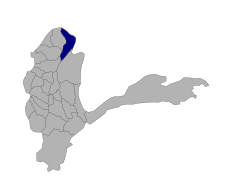| Darwazi Bala (ولسوالی دروازبالا (نسی | |
|---|---|
 | |
| Coordinates: Coordinates: 38°08′40″N71°14′01″E / 38.14444°N 71.23361°E | |
| District | Badakhshan |
| Government | |
| • Type | District council |
| Population | |
| • Estimate ([ citation needed ]) | 11,000 |

Darwazi Bala, also known as Nusay, [1] is a district in Badakhshan Province, Afghanistan. It was created in 2005 from part of Darwaz District. It is home to approximately 11,000 residents.

Badakhshan Province is one of the 34 provinces of Afghanistan, located in the farthest northeastern part of the country between Tajikistan and northern Pakistan. It shares a 56.5-mile (91 km) border with China.

Darwaz district was a district in Badakhshan Province in Afghanistan until 2005. It was part of the historic region Darwaz which is now divided between Afghanistan and Tajikistan. In 2005 Darwaz District was subdivided into Maimay District, Darwazi Bala District, and Shekay District. Some maps use the name Darwaz for Maimay District. The district was historically part of the Darvaz principality, a semi-independent statelet ruled by a mir.
This district borders the Shekay, Kuf Ab, and Maimay districts, along with districts in Darvoz, Gorno-Badakhshan Autonomous Province, Tajikistan.

Shekay or Shikai Persian: شهرستان شِکی is one of the 28 districts of Badakhshan Province in northeastern Afghanistan. It was created in 2005 from part of Darwaz District and is home to approximately 26,000 residents. This district borders Nusay and Kuf Ab districts in Badakhshan and also Darvoz District in the Gorno-Badakhshan Autonomous Region of Tajikistan.

Kuf Ab is one of the 28 districts of Badakhshan Province in eastern Afghanistan. It was created in 2005 from part of Khwahan and is home to approximately 21,400 residents. This district borders with the Districts Khwahan, Shekay, Nusay, Maimay, Raghistan, And with is district Darvoz Gorno-Badakhshan Autonomous Province,

Maimay, also known as Darwaz-e Payin, or simply Darwaz, is a district in Badakhshan Province, Afghanistan. It was created in 2005 from part of Darwaz District. It is home to approximately 12,000 residents. This district borders the Kuf Ab, Raghistan, Shighnnan, and Nusay districts, along with some districts in the Gorno-Badakhshan Autonomous Province, Tajikistan, including Vanj, Rushon, and Shughnon. The district was historically part of the Darwaz principality, a semi-independent statelet ruled by a mir.
The district was historically part of the Darvaz principality, a semi-independent statelet ruled by a mir . [2]

Darvaz, alternatively spelt Darwaz, Darvoz, or Darwoz, was an independent principality until the 19th century, ruled by a mir and its capital was at Kalai-Khumb. The kingdom controlled territory on the left and right banks of the Oxus River. In 1878 Darvaz was invaded by neighboring Bukhara and absorbed into the Bukharan Emirate. In 1895 the left bank of Darvaz was transferred to Afghanistan as part of a border agreement. In the 1920s the portion of Darvaz located in the Tajik Soviet Socialist Republic in the Soviet Union was assigned to the Gharm Oblast. When the Gharm Oblast was dissolved in 1955, Darvaz became part of the Gorno-Badakhshan Autonomous Oblast.
Mir is a rare ruler's title in princely states and an aristocratic title generally used to refer to a person who is a descendant of a commander in medieval Muslim tradition.







